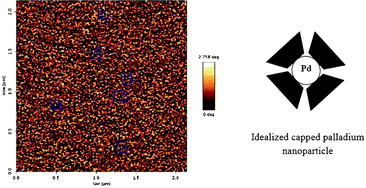The process of formation of narrow size spherical PdNPs covered by cyclodextrins with an average size of 5.1 nm ± 0.5 nm has been investigated in aqueous solution at room-temperature. Analyses by UV-Vis spectroscopy and dynamic light scattering (DLS) at the beginning of reaction indicated a fast exchange of chloride ions with water molecules within the palladium coordination sphere. This process is followed by reduction of Pd(II) species according to the α-HPCD concentration. The hydrodynamic radii observed from both PdNPs and α-HPCD aqueous solutions suggested that regular CDs assemblies in the order of a few nanometers may direct the homogeneous NPs growth towards uniform aggregates. These scattering measurements are corroborated by 1H DOSY NMR spectroscopy in solution and AFM (atomic force microscopy) analyses which provided evidence of stable hybrid assemblies. Interestingly, by changing the cavity size, structures with distinct hydrodynamic diameters are formed. Further evidence from ECD (electronic circular dichroism) spectra reveals that the primary face of cyclodextrin is most likely associated to the metal surface.

